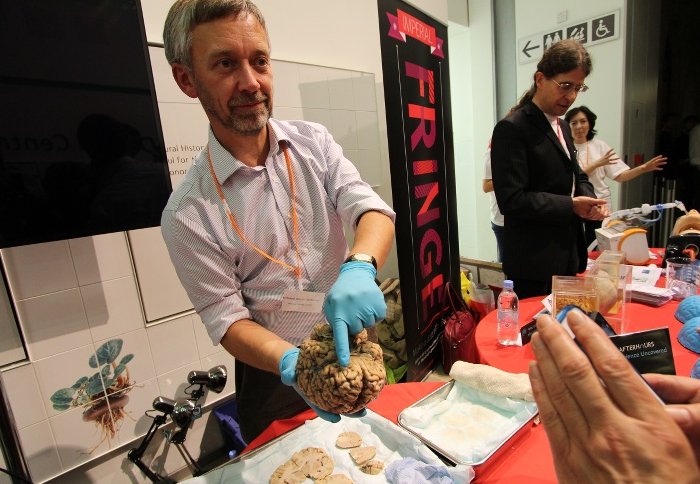
Professor Stephen Gentleman describes parts of the brain at Science Uncovered 2012

Researchers from Imperial College London took part in Science Uncovered 2012 at the Natural History Museum last month.
Imperial scientists put their research on display last month at Science Uncovered - the Natural History Museum’s biggest after hours event attended by 8,500 visitors, which took place as part of the European Commission’s Researchers’ Night.
More than 500 museum staff, including 350 scientists and visiting researchers from over 26 organisations joined forces to deliver the programme of talks, demonstrations and interactive research displays, with rotating exhibitions running from 16.00 until 23.00.
The Imperial zone occupied a pop-up science station just off the Central Hall, where demonstrations included a human brain, brought from the Brain Bank by Professor Steve Gentleman (Medicine), who talked about his research into Parkinson’s disease by studying physical changes in the human brain. Also in action was a workshop on how to extract DNA from strawberries, a demonstration of how beetles polarize light, and an interactive display from Dr Robert Dickinson’s group (Surgery and Cancer) on how Xenon gas could be used to reduce certain types of brain trauma.
Dr Dickinson said: “This was the first experience of public engagement for myself and my PhD students, and we thoroughly enjoyed it. Science Uncovered allowed us to communicate our work on Traumatic Brain Injury to a different and much wider public than we are used to. The experience was a two-way process, because we also learned from it. We were pleasantly surprised at the turnout on the night and by the amount of interest our stand generated amongst the visitors. We were so busy that three hours just flew by, with opportunities to talk with people of all ages and expertise.
“Afterwards, one of my students observed: ‘In order to communicate our research to the public we had to explore the bigger picture of what our research could really mean to people. Sometimes focusing day to day on small parts of a project makes you forget this bigger picture. This event helped remind me how passionate we are about our ultimate goal – developing treatments that may help brain-injured patients.’ ”
The event also featured Imperial PhD students who took on the mantle of ‘Soapbox scientists’ for the evening, adopting their podium positions to hold forth on contentious areas of scientific debate, such as genetic modification of food crops, and censorship in science.
Imperial’s exhibiting scientists were met with an inquisitive crowd, who with camera-phones at the ready, took the opportunity to examine the artifacts, models and diagrams on show, and pose all manner of questions. One exhibiting scientist observed on Twitter, “The public really do care about science!”
- Caroline Prew, Communications and Development
Next year, Researchers’ Night takes place on Friday 27 September 2013. In the meantime, you can catch up with interactive demonstrations about Imperial research at the monthly Imperial Fringe events.
Science Uncovered in pictures
Article text (excluding photos or graphics) available under an Attribution-NonCommercial-ShareAlike Creative Commons license.
Photos and graphics subject to third party copyright used with permission or © Imperial College London.
Reporter
Caroline Prew
Communications and Development

Contact details
Email: press.office@imperial.ac.uk
Show all stories by this author




Leave a comment
Your comment may be published, displaying your name as you provide it, unless you request otherwise. Your contact details will never be published.